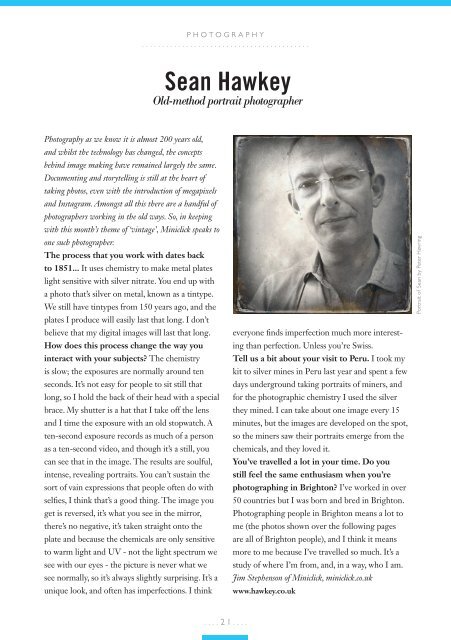Create successful ePaper yourself
Turn your PDF publications into a flip-book with our unique Google optimized e-Paper software.
photography<br />
..........................................<br />
Sean Hawkey<br />
Old-method portrait photographer<br />
Photography as we know it is almost 200 years old,<br />
and whilst the technology has changed, the concepts<br />
behind image making have remained largely the same.<br />
Documenting and storytelling is still at the heart of<br />
taking photos, even with the introduction of megapixels<br />
and Instagram. Amongst all this there are a handful of<br />
photographers working in the old ways. So, in keeping<br />
with this month’s theme of ‘vintage’, Miniclick speaks to<br />
one such photographer.<br />
The process that you work with dates back<br />
to 1851... It uses chemistry to make metal plates<br />
light sensitive with silver nitrate. You end up with<br />
a photo that’s silver on metal, known as a tintype.<br />
We still have tintypes from 150 years ago, and the<br />
plates I produce will easily last that long. I don’t<br />
believe that my digital images will last that long.<br />
How does this process change the way you<br />
interact with your subjects? The chemistry<br />
is slow; the exposures are normally around ten<br />
seconds. It’s not easy for people to sit still that<br />
long, so I hold the back of their head with a special<br />
brace. My shutter is a hat that I take off the lens<br />
and I time the exposure with an old stopwatch. A<br />
ten-second exposure records as much of a person<br />
as a ten-second video, and though it’s a still, you<br />
can see that in the image. The results are soulful,<br />
intense, revealing portraits. You can’t sustain the<br />
sort of vain expressions that people often do with<br />
selfies, I think that’s a good thing. The image you<br />
get is reversed, it’s what you see in the mirror,<br />
there’s no negative, it’s taken straight onto the<br />
plate and because the chemicals are only sensitive<br />
to warm light and UV - not the light spectrum we<br />
see with our eyes - the picture is never what we<br />
see normally, so it’s always slightly surprising. It’s a<br />
unique look, and often has imperfections. I think<br />
everyone finds imperfection much more interesting<br />
than perfection. Unless you’re Swiss.<br />
Tell us a bit about your visit to Peru. I took my<br />
kit to silver mines in Peru last year and spent a few<br />
days underground taking portraits of miners, and<br />
for the photographic chemistry I used the silver<br />
they mined. I can take about one image every 15<br />
minutes, but the images are developed on the spot,<br />
so the miners saw their portraits emerge from the<br />
chemicals, and they loved it.<br />
You’ve travelled a lot in your time. Do you<br />
still feel the same enthusiasm when you’re<br />
photographing in <strong>Brighton</strong>? I’ve worked in over<br />
50 countries but I was born and bred in <strong>Brighton</strong>.<br />
Photographing people in <strong>Brighton</strong> means a lot to<br />
me (the photos shown over the following pages<br />
are all of <strong>Brighton</strong> people), and I think it means<br />
more to me because I’ve travelled so much. It’s a<br />
study of where I’m from, and, in a way, who I am.<br />
Jim Stephenson of Miniclick, miniclick.co.uk<br />
www.hawkey.co.uk<br />
Portrait of Sean by Peter Høvring<br />
....21....


















